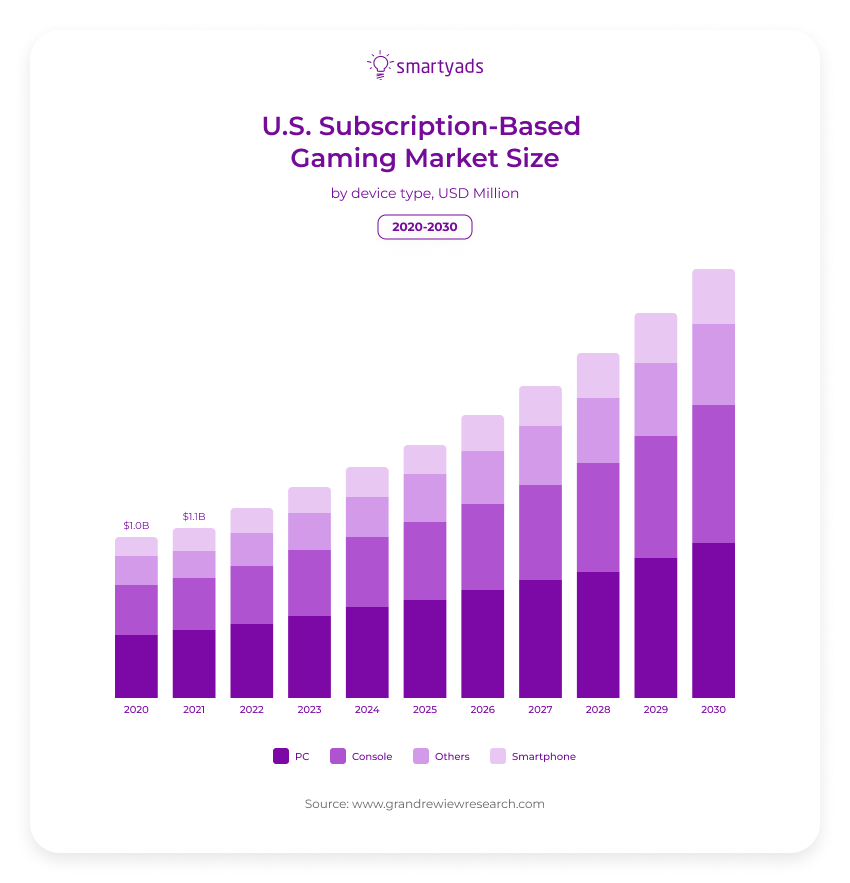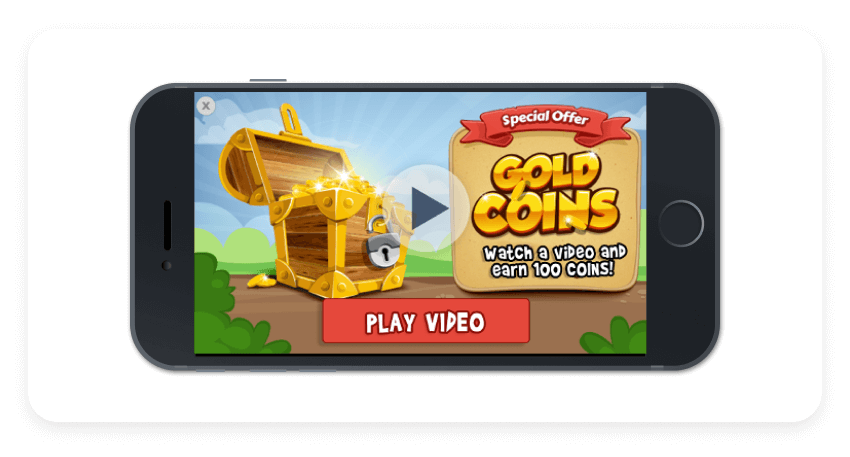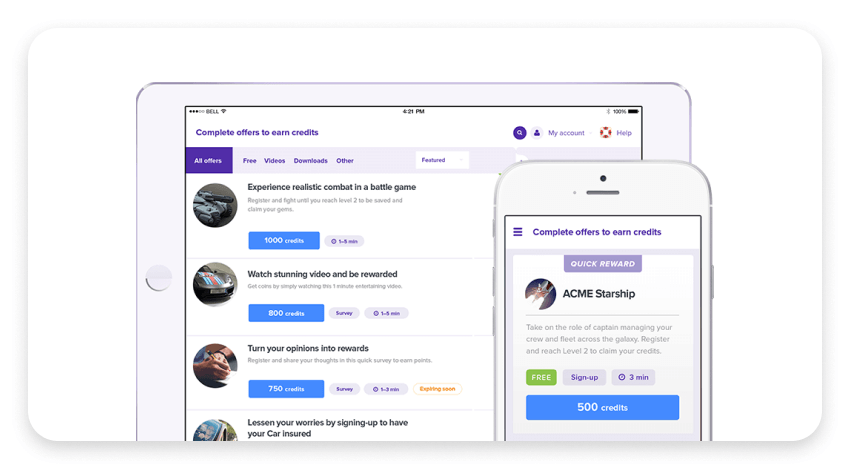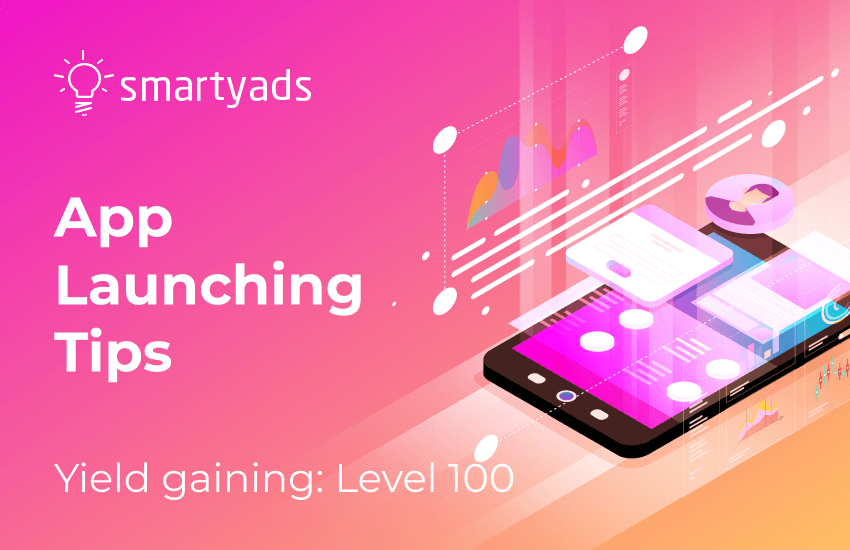The mobile gaming industry continues to evolve. Driven by rapid technological advancements, mobile gaming is set to redefine the way players interact with games, pushing the boundaries of creativity, engagement, and monetization.
The future of mobile gaming promises an immersive and dynamic experience for players and endless opportunities for developers and advertisers. So, let's explore these biggest mobile gaming industry trends to find out how advertising in popular games is happening.
Key Takeaways:
- Mobile Gaming Growth: Mobile gaming is booming, with global revenue expected to reach $105.7 billion in 2025. This growth is fueled by smartphone adoption, affordable internet, and the rise of free-to-play games.
- Game Trends: Popular genres include hyper-casual games, puzzle games with added gameplay layers, and mobile eSports. Artificial intelligence and cloud gaming are also revolutionizing the industry.
- Monetization Strategies: In-app purchases, subscriptions, battle passes, and rewarded ads drive revenue. SmartyAds SSP helps developers and publishers optimize monetization with targeted ads and comprehensive solutions.
- Future Outlook: The mobile gaming industry will continue to innovate, integrating AR/VR, cross-platform experiences, and data monetization, creating endless opportunities for developers.

Mobile market trends
The mobile gaming market is experiencing unprecedented growth, with impressive revenue projections, user expansion, and regional dominance shaping its trajectory. Before we delve into gaming industry trends, let’s see some statistics:
- Global mobile gaming revenue is projected to reach $105.7 billion in 2025.
- The market is expected to grow at a 6.06% compound annual growth rate (CAGR) from 2025 to 2027, reaching a value of $118.9 billion by 2027.
- The number of users in the mobile gaming segment is predicted to hit 1.9 billion by 2027.
- User penetration is forecasted to rise from 22.5% in 2025 to 23.3% in 2027.
- China is expected to lead the global market, generating an estimated $36.89 billion in revenue in 2025.
- The average revenue per user (ARPU) for mobile games is projected to be $60.15 in 2025.
- In the United States, mobile gaming revenue is experiencing significant growth, fueled by high smartphone adoption and rising demand for immersive gaming experiences.
.webp)
As you can see, the mobile gaming market is at its peak. In 2025, this type of entertainment will generate over half of the global gaming revenue, surpassing PC and console combined. This growth is fueled by widespread smartphone adoption, affordable internet access, and the increasing popularity of free-to-play games with in-app purchases.
Casual and hyper-casual games dominate the charts, thanks to their accessibility and shorter play sessions, while mid-core and hardcore games are gaining traction among dedicated players. Emerging technologies like cloud gaming and 5G connectivity are enabling seamless gameplay, even on low-spec devices.
Additionally, the integration of social and multiplayer features has turned mobile gaming into a community-driven activity, further enhancing player retention.
Monetization strategies are also evolving, with in-app advertising, rewarded ads, and battle passes driving revenue. Meanwhile, privacy regulations are pushing developers and advertisers to innovate while respecting user data. The market is thriving, but competition is fierce, requiring developers to stay ahead by leveraging the latest trends and technologies.
It is already clear to us that the mobile gaming market is currently the driving force behind the entire gaming industry, but let's take a closer look at the major trends in gaming industry.
Hyper-casual games
At least by the number of downloads in the US, the hyper-casual games are still in first place for the last couple of years.
If you are a big fan of the hyper-casual genre, then you will be happy to know that it is here to stay, and we can safely add it to the list of trends in mobile gaming. Hyper-casual games are very lightweight, which makes them suitable for most mobile devices.
Such mobile video games have very basic mechanics and provide instant gameplay. Some big names in the hyper-casual genre are examples such as Base Attack, Blob Runner, Catch And Shoot, and many others.
Hyper-casual apps require little time for development and production. Besides, they offer a simple interface without any tutorials.
The mobile gaming market analysis shows that an increasing number of gaming companies are entering the hyper-casual gaming area. Some companies intend to do it independently, while others focus on acquiring smaller competitors.
The competition for acquiring new casual mobile gaming industry users will be fierce. Developers who lack the money to stay competitive will have to transition to publishing deals or selling their businesses.
Puzzle mobile games
Puzzles are one of the favorite subgenres and the hot type of trend mobile games. One of the latest puzzle genre trends is adding extra gameplay and the appearance of new meta-layers.
It's hard to come up with something new in match-3 games and even harder to compete with such giants of the mobile games market as Candy Crush, which is a recognized and deserved leader in this field.
Elements of additional gameplay and meta-layers can be seen in puzzle games like Homescapes, Gardenscapes, Clockmaker, and even successful new puzzle games like Project Makeover, which have meta-layers of fashion, decor, and storytelling.
Such a strategy allows developers to target a broader audience. It turns out that instead of focusing on players who prefer match-3 games, they may also interest female gamers or enthusiasts of storytelling, design, or logic puzzles.
All of this is a result of market saturation. Many one-size-fits-all offerings make users selective, so mobile game developers should have creative teams to invent new ways to entertain players. But, thanks to this, the core games industry continues to evolve, so it's all for the best.
As the industry continues to develop, we can anticipate even more innovative features like integrated live streams and AI-enhanced interactions, ensuring that social gaming stays at the cutting edge of mobile gaming trends.
Mobile eSports
Mobile eSports has become a significant force in the competitive entertainment landscape, engaging millions of players and fans around the globe. Thanks to the widespread use of mobile devices and the emergence of high-quality competitive games, this sector has established itself alongside traditional PC and console eSports. Games like PUBG Mobile, Free Fire, and Mobile Legends: Bang Bang have drawn large audiences, with tournaments offering prize pools that compete with those of established competitions.
A key factor in the rise of mobile eSports is its accessibility. Unlike PC or console competitions, which often require hefty investments in hardware, mobile eSports is available to anyone with a smartphone. This has opened up competitive gaming to a broader audience, especially in regions like Southeast Asia, India, and South America, where mobile users are prevalent.
Streaming platforms such as YouTube and Twitch have also contributed to its growth, enabling players to display their talents and engage with audiences worldwide. Game developers are increasingly designing their titles for competitive play, incorporating features like ranked modes, spectator options, and regular updates to keep players engaged.
With increasing sponsorships, partnerships, and a loyal fan base, mobile eSports is redefining the future of competitive entertainment, breaking down barriers, and bringing communities together through shared experiences.
Artificial intelligence
Artificial intelligence (AI) is transforming digital entertainment by improving user experiences and streamlining development processes. With AI, developers can craft more immersive environments, create dynamic interactions, and offer personalized content that caters to individual tastes. Machine learning algorithms assess player behavior to modify difficulty levels, suggest content, and enhance in-app experiences, keeping users engaged for extended periods.
AI's influence goes beyond just user engagement. In the development phase, it speeds up tasks like asset creation, testing, and debugging. AI-driven procedural generation allows for the creation of expansive, intricate environments with minimal manual effort, conserving both time and resources. This technology also enhances quality assurance, as AI-based testing can detect bugs and inconsistencies more effectively than traditional approaches.
From a business perspective, AI is a significant asset for marketing and monetization strategies. It analyzes user data to provide targeted advertisements and personalized promotions, maximizing return on investment while improving user satisfaction. Predictive analytics also play a crucial role in spotting trends and anticipating user behavior, enabling developers and publishers to maintain a competitive edge in the market.
As AI continues to advance, its uses are broadening into areas such as voice recognition, real-time translation, and sophisticated NPC behavior, making experiences more intuitive and engaging. This groundbreaking technology is redefining the landscape of digital entertainment.
App Store continues to impact the mobile gaming industry
Apple's change in the use of IDFA will continue to impact mobile game advertising greatly. Targeted advertising has become much stricter, directly affecting user acquisition, engagement, and monetization.
But because, in this case, there are users' personal data at stake, not only the income of game companies, it is unlikely that there will be any easing of the situation in the near future, as it happened with Google Play Store, for example, that reduced commissions for small mobile games developers from 30% to 15%.
So the only logical and adequate solution for developers seems to be to adapt to the current realities and look for new channels to attract users. One can take advantage of offline advertising or DOOH, for example.
This also means that in the current realities, advertising creatives are a crucial part of advertising in the mobile game market. Mobile game publishers will have to pay close attention to this.
Collaborations between brands and IPs
Collaborations between brands and intellectual properties (IPs) have emerged as a potent strategy in the digital entertainment sector, providing significant advantages for both sides. By partnering with well-known franchises, developers can craft unique, immersive experiences that draw in new audiences while enhancing engagement with current players. At the same time, brands tap into extensive, dedicated communities, broadening their reach and increasing visibility.
These collaborations frequently lead to limited-time events, exclusive skins, or themed challenges that excite fans and instill a sense of urgency. For example, partnerships with movie franchises, celebrities, or sports leagues can revitalize digital platforms, sparking interest and building loyalty. Games like Fortnite have excelled in this area, showcasing collaborations with Marvel, Star Wars, and even global pop icons, creating moments that go beyond their original context.
For brands, this strategy offers a vibrant way to engage with younger, tech-savvy audiences. By integrating smoothly into interactive platforms, they gain genuine, impactful exposure without interrupting user experiences.
As the industry progresses, collaborations between brands and IPs are becoming increasingly innovative, merging storytelling with interactivity. These partnerships extend beyond mere marketing—they are crafting cultural moments that resonate with audiences long after the campaigns conclude. This trend underscores the expanding potential of cross-industry collaborations.
Independent game stores
Let’s move on with mobile game industry trends. Leading mobile app stores — Apple App Store and Google Play Store — were forced to allow developers to sell cross-platform apps. This is quite a significant event because it will enable developers to monetize apps outside the official stores and not depend on the commission set by Google and Apple.
Of course, the marketplaces would not benefit from this, but they were forced to agree to it by law. US courts issued a permanent injunction in September 2021 in response to the Epic vs. Apple lawsuit (although both sides have recently appealed this decision). This is also governed by the European Commission's Digital Markets Act.
This is quite significant for developers, as independent game stores served by third parties offer lower fees and more payment options while allowing them to offer branded, consumer-oriented content.
Forward-thinking developers and publishers will continue operating existing stores, directing users to more profitable outlets.
Social functions of mobile games
Social gaming has changed how people interact with mobile games, turning it into more than just a solo activity. By incorporating multiplayer features and social elements, gaming has evolved into a community-focused experience, creating connections among players around the globe. Whether it's teaming up for challenges, competing on leaderboards, or sharing achievements on social media, social gaming promotes interaction and fosters a sense of belonging.
Now two-thirds of the top 50 mobile games have at least one feature that allows players to communicate with each other.
These features may include:
- in-game chat;
- connection to social networks;
- guilds;
- cooperative modes;
- PvP modes.
A major factor behind the success of social gaming is its ability to tap into the inherent human need for connection. Games that include social features like chats, friend invites, and collaborative gameplay tend to be especially popular. Titles such as Among Us and Clash of Clans have taken advantage of this trend, building vibrant communities of players who regularly engage with both the game and one another. According to Facebook, "Four in ten (38%) new players in the US said they prefer to chat with others when playing, compared to three in ten (29%) existing players in the US who said the same".
We can see developers adding communication functionality to their mobile games. This is especially common in the Asian mobile gaming segment (for example, the already mentioned Genshin Impact has a cooperative mode in addition to player chats and events in which users can participate together with other players).
However, the Western mobile gaming market is not lagging behind: Call of Duty: Mobile added rooms for partying and Roblox, where players can enjoy the show.
However, the reason for adding these features is the need for greater player satisfaction and the possibility of monetization. Because these rooms are often a place to show off your avatar, skins, and gear; also, it's a great way to improve user retention.
Additionally, social gaming offers profitable opportunities for advertisers and developers. With social sharing and word-of-mouth marketing, games that incorporate social mechanics often see improved user retention and organic growth. Furthermore, social gaming encourages deeper engagement, making it a prime platform for in-game advertising and brand partnerships.
Cloud gaming on the rise
Cloud gaming is quickly changing the gaming landscape, providing a smooth and accessible experience for players worldwide. By moving the processing power to cloud servers, this technology enables users to enjoy high-quality games without needing expensive hardware. With just an internet connection and a device like a smartphone, tablet, or laptop, players can instantly access their favorite titles.
A major factor driving the growth of cloud-based platforms is the increasing availability of high-speed internet and 5G networks. These advancements guarantee low-latency, high-performance experiences, even for resource-intensive games. Companies such as Google Stadia, NVIDIA GeForce NOW, and Xbox Cloud Gaming are leading the charge by offering subscription-based services that provide premium experiences.
Cloud platforms also remove the hassle of regular updates and storage issues, making them more user-friendly and cost-effective. For developers and publishers, this model creates new opportunities for subscription revenue and a broader audience reach.
As technology continues to advance, the potential for incorporating virtual reality (VR), augmented reality (AR), and other immersive features further boosts the attractiveness of cloud services. The emergence of this innovation signifies a major shift, making interactive entertainment more inclusive and accessible than ever.
AR and VR integration
Augmented reality (AR) and virtual reality (VR) are transforming the digital landscape at an incredible pace, providing levels of immersion and interactivity that were previously unimaginable. By merging the physical and digital game realms, AR and VR create experiences that captivate users. These technologies are increasingly being incorporated into mobile and interactive platforms, enhancing user engagement and changing the way people interact with digital content.
AR enriches the real world by superimposing digital elements, allowing users to engage with virtual objects within their actual surroundings. Popular applications like Pokémon GO have showcased AR’s ability to bridge the gap between the virtual and real worlds, promoting exploration and social interaction. On the other hand, VR delivers fully immersive, computer-generated environments, enabling users to enter entirely new worlds and experience them as if they were truly there.
The integration of AR and VR into mobile platforms is particularly noteworthy, as these technologies were once confined to high-end devices. With the increasing capabilities of smartphones and wearables, a larger audience can now access these experiences, leading to wider adoption. Brands are utilizing AR and VR for interactive marketing campaigns, product demonstrations, and virtual events, creating innovative methods to engage consumers.
As AR and VR technologies continue to evolve, the possibilities for new, immersive experiences will only grow, opening up exciting avenues for entertainment, education, and commerce.
Monetization in mobile gaming world
Mobile game industry leaders rely heavily on in-app purchases and subscription-based monetization models. This has proven to be very successful. However, more and more IAP game developers have also started to implement in-game advertising. Not only do ads serve as an additional source of revenue, but they can also increase in-app purchases.
Monetization by subscription
Mobile game subscriptions can take different forms and work according to different principles, so that this popular monetization method can suit many developers.
In addition, these types of subscriptions can combine different types of monetization (for example, a battle pass can be replaced by advertising with rewards, and a subscription for the no ads can easily pay for the presence of these very ads in the free-to-play version).
Some examples of subscriptions in mobile games:
- Battle Passes (e.g., Fortnite, Genshin Impact, PUBG Mobile);
- Booster subscriptions (e.g., Boom Beach);
- VIP access (e.g., Wheel of Fortune);
- Remove Ads subscriptions (e.g., Sand Balls).
Additionally, subscriptions are very often combined with in-app purchases and are not the only form of monetization in the mobile gaming market.

Rewarded video
The rewarded video is an especially promising format. In fact, according to a recent study, users prefer rewarded video ads, so the engagement rate for this format is very high and usually stays at level 92%.
The opt-in rate reaches 79%, almost impossible to accomplish with any other ad format. This ad unit is so memorable because the user watches the ad video until the end to get an in-game reward afterward.
This way, advertisers who use rewarded ads always receive impeccable completion rates. At the same time, game publishers also profit as player engagement and retention rates increase.

Offer Walls
The age-old offer wall is not going anywhere since it is a very useful tool to monetize users who are not willing to spend money on apps. An offer wall is a page that appears in front of users while the app is browsing. It usually offers them various rewards if they spend some money or complete an action.
Offer walls are also starting to be used in non-gaming apps like messengers and dating applications. Such a non-disruptive opt-in format helps boost engagement and increase retention while providing game publishers and developers with a good payout.

What’s next?
All the trends mentioned above show that the mobile games industry only continues to grow. All kinds of new technologies are being created to engage the users in mid-core games and immerse them in the gameplay.
People want to play mobile games. Currently, they represent half of the entire gaming industry.
Keep in mind that monetization does not have to be solely focused on in-app purchases or advertising. Whenever users download apps, they leave valuable information such as name, age, email address, phone number, and other details, making a treasure trove of information for the digital industry.
This information can reveal many insights businesses can turn into millions of dollars. In this quest, mobile app developers could be the biggest winners within the industry.
They have access to tons of information. Even though data monetization is still one of the emerging trends, it could be a very effective mobile monetization platform for publishers and app developers.
A wrap-up
Online games and mobile ones are quickly swooping IOS and Android users in. Cross-platform experiences, influencers, mobile esports, and streaming services define the modern mobile games trends.
SmartyAds provides ad monetization solutions for digital publishers and app developers to monetize their digital space.
On the SSP platform, you will be offered highly contextualized advertising so that you can generate the most value from user engagement. Give your monetization effort a jumpstart with the SmartyAds SSP.
Create your SSP account to get the most value out of your inventory!




![In-App Advertising: the Complete Guide [Updated 2025]](/storage/uploads/2020/september/in-app-advertising-trends.png)
